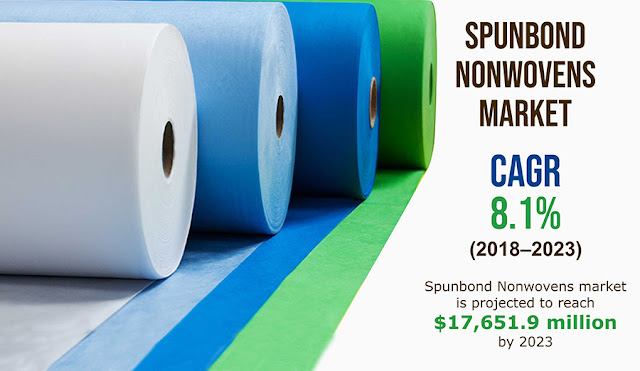Expanding Medical Industries Augmenting the Spunbond Nonwovens Market Growth
The rising penetration of spunbond nonwoven fabrics in the manufacturing of wipes, adult incontinence products, diapers, surgery clothing, and female hygiene products and the expansion of the medical industry in developing economies are responsible for the growth of the spunbond nonwovens market. In 2017, the market attained a size of $11,040.1 million, and it is predicted to witness a CAGR of 8.1% during the forecast period (2018–2023). Spunbond nonwoven is created by bonding long fibers and staple fibers together, in which the fibers are dispersed and spun into a web by deflectors.
Get a Sample Copy of this Report @ https://www.psmarketresearch.com/market-analysis/spunbond-nonwovens-market/report-sample
On the basis of material type, the spunbond nonwovens market is categorized into polyester, polypropylene, polyethylene, and polyurethane. Out of these, in 2017, the polypropylene category held the largest revenue share of more than 65.0%, and it is anticipated to dominate the market during the forecast period too. Polypropylene is widely preferred owing to its advantageous properties such as low price and density, and high hydrophobicity and chemical resistance, which make it ideal for surgical clothing, diapers, and other disposable products.
Based on application, the spunbond nonwovens market is classified into medical, hygiene and personal care, agriculture, automotive, packaging, and building and construction. In 2017, among these, the hygiene and personal care classification held more than 35.0% revenue share in the market, and it is expected to lead it during the forecast period. Baby diapers, adult diapers, and personal wipes are manufactured by using spunbond nonwovens, and the demand for these products is rising in Asian countries owing to increasing hygiene consciousness.
Make Enquiry Before Purchase @ https://www.psmarketresearch.com/send-enquiry?enquiry-url=spunbond-nonwovens-market
Due to the surging population in African and Asian countries, the sales of these products are predicted to accelerate at a significant pace. This, in turn, would escalate the demand for spunbond nonwoven fabrics as a raw material in manufacturing units, thereby resulting in growth of the spunbond nonwovens market. In recent years, a large number of Central European countries have been observing improvements in the healthcare and medical industries, as a result of which the life expectancy has increased and people nowadays are able to avail improved healthcare facilities.
The growing number of rural and urban healthcare facilities, such as clinics and hospitals, is enhancing the quality of medical services in the region. Furthermore, with the surging penetration of medical facilities, the use of products such as drapes, face masks, gloves, and patient gowns, which are essential for the prevention of hospital-acquired infections has increased, resulting in the swift adoption of disposable nonwoven fabrics for their manufacturing. Thus, the better availability of medical services in Central Europe is expected to boost the progress of the spunbond nonwovens market.
Browse Overview of this Report @ Global Market Size, Share, Development, Growth, and Demand Forecast, 2013–2023
Nations including India, Indonesia, China, Nigeria, Poland, and Malaysia, have exhibited rapid economic growth in the past few years. The majority of these countries have huge populations as well as better living standards compared to several years ago. These factors make these a suitable market for hygiene and personal care and medical products. Apart from this, these nations have fast-growing automotive and construction industries, which consume spunbond nonwovens in large quantities. Hence, developing economies with a high economic growth rate are expected to witness an escalated demand for such materials during the forecast period.
Thus, the expanding medical and other end-use industries in developing nations is heavily contributing to the growth of the market.

Comments
Post a Comment